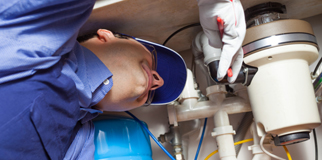Leading Methods for Resolving a Leak in Your Garbage Disposal
Leading Methods for Resolving a Leak in Your Garbage Disposal
Blog Article
Here down the page you will discover a lot of worthwhile news in relation to Why Is .

Garbage disposals are crucial kitchen home appliances that aid in throwing away food waste successfully. Nonetheless, a dripping waste disposal unit can be a frustrating and messy trouble to manage. The good news is, many leaks can be fixed quickly with a couple of easy actions. In this short article, we will certainly go over exactly how to fix a dripping garbage disposal properly.
Intro
Waste disposal unit are installed under cooking area sinks and are developed to shred food waste right into smaller items, enabling it to go through the plumbing system quickly. While these tools are usually dependable, leaks can happen with time because of damage, loosened connections, or damages to the unit.
Usual Causes of Leakages in Garbage Disposals
Worn Seals and Gaskets
Seals and gaskets play an essential duty in preventing water from leaking out of the garbage disposal. With time, these components can deteriorate, bring about leaks around the disposal system.
Loose Connections
The connections between the garbage disposal and the pipes system can come to be loosened over time, causing water to leak out during procedure.
Fractures or Openings in the Disposal Device
Physical damages to the garbage disposal, such as cracks or openings in the real estate, can additionally result in leaks.
Determining the Source of the Leak
Prior to trying to take care of a leaking garbage disposal, it is essential to identify the resource of the leakage. This can usually be done via visual assessment or by performing straightforward tests.
Visual Evaluation
Evaluate the garbage disposal device meticulously for any indications of water leak. Pay close attention to locations around seals, gaskets, and link factors.
Testing for Leakages
One means to evaluate for leakages is by running water with the disposal device and looking for any type of visible signs of leakage.
Tools and Products Needed for Dealing With a Dripping Waste Disposal Unit
Before starting the fixing procedure, gather the required tools and products, consisting of a screwdriver, flexible wrench, plumbing's putty, replacement seals or gaskets, and epoxy or patching material for repairing splits or holes.
Step-by-Step Guide to Fixing a Dripping Waste Disposal Unit
Turn Off the Power
Before trying any kind of fixings, guarantee that the power to the garbage disposal system is turned off to avoid the threat of electric shock.
Situate the Leak
Determine the exact place of the leakage and identify the cause.
Tighten up Connections
Utilize a wrench to tighten any kind of loosened links in between the disposal device and the pipes system.
Replace Seals or Gaskets
If the leak is due to worn seals or gaskets, get rid of the old elements and replace them with new ones.
Patching Splits or Openings
For splits or holes in the disposal unit, usage epoxy or an ideal patching product to secure the broken area.
Checking the Waste Disposal Unit After Fixing
As soon as the fixing is total, check the waste disposal unit by running water via it to make sure that the leak has actually been resolved.
Preventive Upkeep Tips to Avoid Future Leakages
To avoid future leaks, it is necessary to execute routine maintenance on your waste disposal unit. This includes keeping it tidy, staying clear of putting non-food products or tough objects down the disposal, and regularly checking for leakages or various other concerns.
Verdict
In conclusion, repairing a leaking waste disposal unit is a reasonably simple process that can be finished with standard devices and materials. By following the actions described in this write-up and practicing precautionary upkeep, you can keep your garbage disposal in good working problem and prevent costly repair services in the future.
HERE’S HOW TO FIX YOUR GARBAGE DISPOSAL
WHAT TO DO IF SOMETHING IS STUCK IN YOUR GARBAGE DISPOSAL
If the impeller won’t turn, there’s probably something stuck in the disposal. It could be a steak bone or peach pit, although plumbers report pulling all sorts of inappropriate objects out of disposals, such as bottle caps or aluminum foil. Make sure power to the disposal is off, and look inside to see if you can see the source of the jam.
Never stick your fingers in a disposal. Pull out anything you see with tongs or pliers.
If the disposal still won’t work, it may be time to call a plumber or consider buying a new disposal. GEM Plumbing & Heating is here for all of your garbage disposal needs.
WHAT TO DO IF YOUR GARBAGE DISPOSAL DRAIN IS CLOGGED
Take everything out from underneath your sink and put a bucket or other container under your disposal to catch any water that drains out. Disconnect your disposal from the power supply. If it’s plugged into a wall outlet, unplug it. If it’s hardwired into an electrical box, go to the electrical panel and turn off the breaker for the disposal. Pour ¼ cup of baking soda into the drain, followed by ½ cup of white vinegar. Give the solution a few minutes to fizz and do its work. Look into the disposal with a flashlight to see if you can see an object that might be causing the clog. If you see it, remove it using tongs or pliers. MORE TIPS ON DEALING WITH A CLOGGED GARBAGE DISPOSAL
Never use drain cleaner in a garbage disposal. It can damage the plastic parts inside the disposal. You can also be splashed with the caustic liquid while working to clear the clog. Beware! Never stick your fingers into a garbage disposal. Trust us — not a good idea. In many instances, your dishwasher drains through your garbage disposal. This allows the disposal to grind any large food particles that may be drained out of your dishwasher. There are some jurisdictions, however, where the plumbing code prohibits such a connection. WHAT TO DO WHEN YOUR DISHWASHER DRAINS THROUGH THE DISPOSAL
Run some water in the sink so your plunger has at least a ½-inch of water to create a seal and plunge vigorously up and down several times. You may need to repeat this several times. Run hot water down the drain to clear any residue that remains.

As a passionate reader about Why Is , I imagined sharing that article was a good idea. Do you know someone else who is truly interested in the subject? Take a moment to promote it. Thanks a lot for going through it.
This Page Report this page